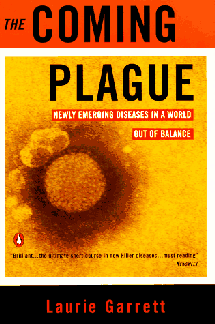Michael Fumento
Factual · Powerful · Original · Iconoclastic
Hysteria Strain of Ebola Fever
January 01, 2001 · Michael Fumento · Washington Times · Disease"There is a crisis brewing in the world that we ignore at our peril. The Ebola virus is back, and it’s spreading." So declared the opening line of a December Business Week article: "Ebola Could Soon Be the West’s Problem, Too."
Soon? Ebola fever is already sweeping the West. But this pathogen is hysteria. And clearly initial infection confers no immunity, because we’ve been through all this before.
Five years ago, after an African epidemic in the Congo, the disease spawned the hit movie Outbreak, with an Ebola-like virus threatening to wipe out the United States, and a TV movie, Virus, starring Ebola itself. CNN gave us a special report, "The Apocalypse Bug," while Newsweek’s cover blared: "Killer Virus."

Making Panic Profitable
The outbreak vaulted Newsday reporter Laurie Garrett’s sensationalist book, The Coming Plague, onto the best-seller list and got her a Pulitzer to boot. Richard Preston also cashed in on Ebola fear with his best-selling The Hot Zone and Garrett is back at it with a new book, Betrayal of Trust: The Collapse of Global Public Health.
The death toll for the 1995 Congo epidemic: 244.
Too many? Yes. But not even a blip on the radar screen of African infectious disease.
But the virus is back and so is the media mayhem.
Talk about an outbreak! From the apparent inception date of the current epidemic in Uganda last October 14th to January 25th of this year, 427 Ebola cases have been reported with 173 deaths. During the same time there were over 1,900 media references to the disease on the Nexis database.
That’s 11 media mentions per fatality.
And while the news is clearly exciting to many of us, it’s also terribly misleading.
Yes, Ebola is a gruesome disease. It causes massive hemorrhage of the internal organs, eyes, and orifices.
But a few facts can dispel a lot of fear.
Ebola is not nearly as lethal as represented. While Garrett has put the figure as "90-plus percent," the media boilerplate is "Ebola has a mortality rate as high as 90%." But how about as low as?
According to a 1996 World Health Organization (WHO) document, the mortality range even back then was 50% to 90%. If the victims had first class hospital care rather than 3rd World treatment, it would be far lower yet.
Further, as treatments have improved, the death rate has dropped. The ratio of deaths to cases in the current outbreak is 40%.
Reporters try to circumvent this inconvenient reality with such rhetoric as "There is no vaccination for Ebola. There is no cure."
True. But the first sentence applies to most viruses, including those causing colds and warts. The second applies to all viruses. That said, an Ebola vaccination has successfully protected monkeys, with human testing coming soon.
Ebola is also terribly difficult to spread. A news report in the Toronto Star claimed, "Ebola is unspeakably evil, and as contagious as the common cold once it gains a foothold."
Aside from pretending that tiny bits of protein have the capacity to make moral decisions, the assertion as to transmissibility is flatly wrong.
Colds are spread through touch and aerosolized droplets, while Ebola is only "transmitted by direct contact with the blood, secretions, organs or semen of infected persons," according to WHO. That’s why those who contract the disease are so often health care workers or family members who prepare the bodies for burial.
Ms. Garrett and Business Week have both asserted that a single airline passenger could be a "patient zero" for a Western epidemic. "It is only a matter of time before an infected person boards a plane and arrives in one of those countries that pays little attention to Africa now," Business Week cluck-clucked.
Wrong.
"It’s possible that someone with Ebola might leave a remote area where the disease is occurring and might even get sick here," Dr. C.J. Peters, chief of the Special Pathogens branch at the federal Centers for Disease Control told me. But, "Because our socioeconomic level allows high standards in hospitals . . . there would be a few cases but they would be controllable under our circumstances."
Ebola has as much chance of spreading in the North America as malaria does in the Arctic.
Finally, even in Africa, Ebola as an infectious disease killer is a pipsqueak.
We hardly need be reminded of the continent’s AIDS problem. But additionally each year sub-Saharan Africa suffers half a million deaths from tuberculosis, and almost 700,000 from malaria. Diarrhea — often a laughing matter in First World countries — kills about 900,000. That’s not particularly funny, is it?

Clearly, some believe Ebola has tremendous entertainment value. But if you’re scared of the virus landing at JFK airport and spreading throughout North America, you’re better off worrying about rabid polar bears in Miami.
And if you’re concerned out of sheer compassion, you should realize that money, researchers, and even worry are all scarce resources and that Ebola has gotten far more than its share.
